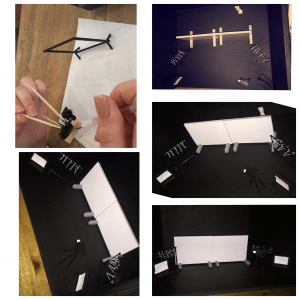![Chase, R. (2015) Username. [ScenicDesignWork] Lincoln 25 February 2015.](https://jumpcuttheatre.blogs.lincoln.ac.uk/files/2015/03/IMG_5263-861x1024.jpg)
The role of the designer within the theatre business is one that commands enormous authority and prestige. This authority stems from the fact that the designer “must share in a production’s creative process with the director” (Llewellyn-Jones, 2001). As the set, costume and props designer for JumpCut, I will visualise and orchestrate the look of the stage and actors; I will work alongside the Director, Chloe-Ann Gudge to understand and realise her initial vision for the performance. I must make certain that I have a clear idea of how she envisions the performance on the stage. So we can begin working collaboratively.
Together in close partnership we will create and articulate a single vision for the performance. By being present at each rehearsal, I will ensure that all stylistic choices made in initial discussions will still work as our performance develops. By working in strict unity with other members of the production, I will ensure that all visual elements merge together to form a well-conceived unity that reflects the style and emotions of the performance. I will make sure that the set design fits the theatrical space to its best advantage and complements the costume/lighting and sound design.
Usually the process of creating a set design begins with the designer’s close study of the script. However, we believe that “devised theatre can start from anything” (Oddy, 2013, 1). JumpCut Theatre are creating a piece revolving around the topic of identity, the use of social media and society’s obsession with idealised beauty. Therefore, I will be creating a set with just the concept in mind.
After amalgamating the information gathered from the various production meetings with the Director, I will begin a series of scale drawings, sketches and model making. These visual representations will hopefully help the director and other members of the production team formulate a more refined production concept.

To aid my process and provide inspiration, I set up a Pinterest account and produced several mood boards to communicate my thoughts and define the visual style of our performance.
Works Cited:
Chase, R. (2015) Username. [Model Stage] Lincoln 2015.
Chase, R. (2015) Username. [ScenicDesignWork] Lincoln 5 March 2015.
Llewellyn-Jones, L. (2001) The Use of Set and Costume Design in Modern Productions of Ancient Greek Drama. [online] Available from:http://www2.open.ac.uk/ClassicalStudies/GreekPlays/essays/designEssay.htm [Accessed 23rd February 2015].
Oddey, A. (2013) Devising Theatre. Hoboken: Taylor and Francis.
Pinterest (2015) JumpCut Mood Boards. [online] Available from https://www.pinterest.com/jumpcut2344/ [Accessed 15 February 2015].






